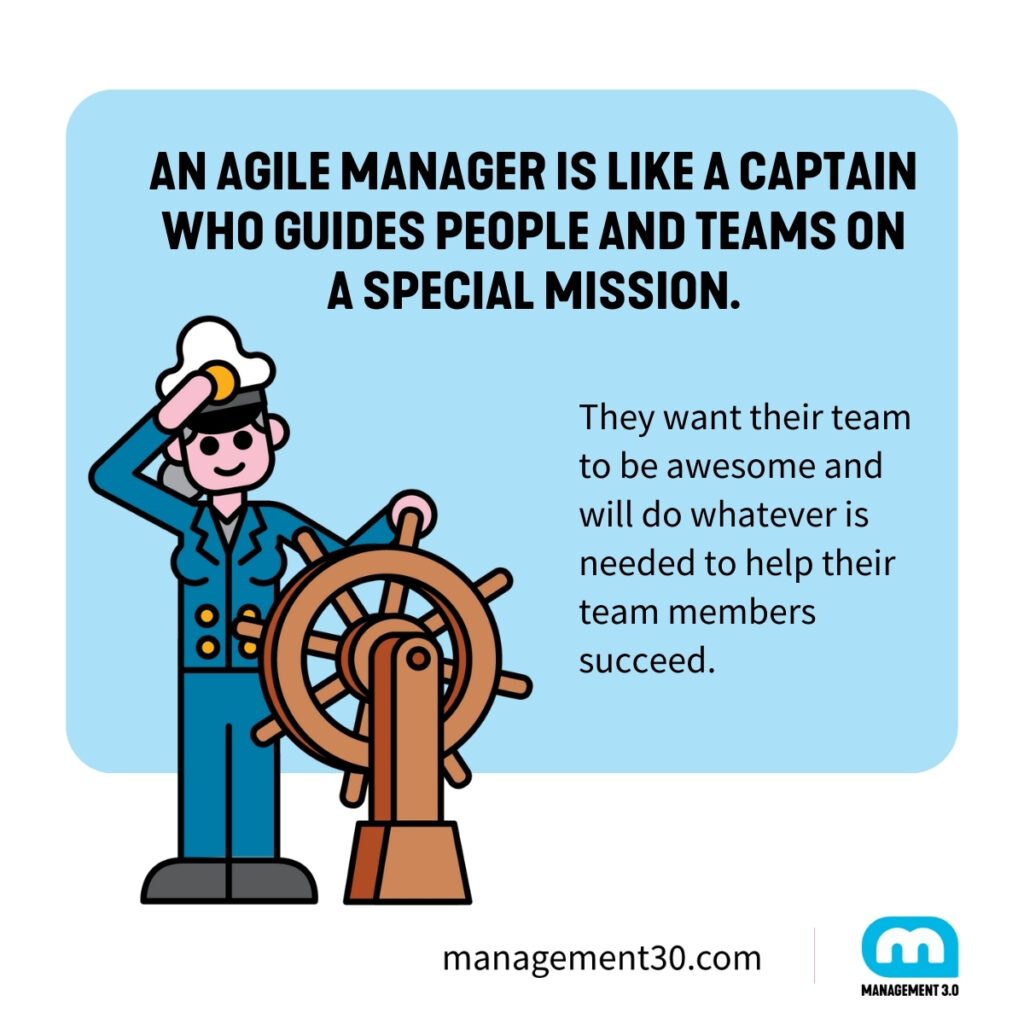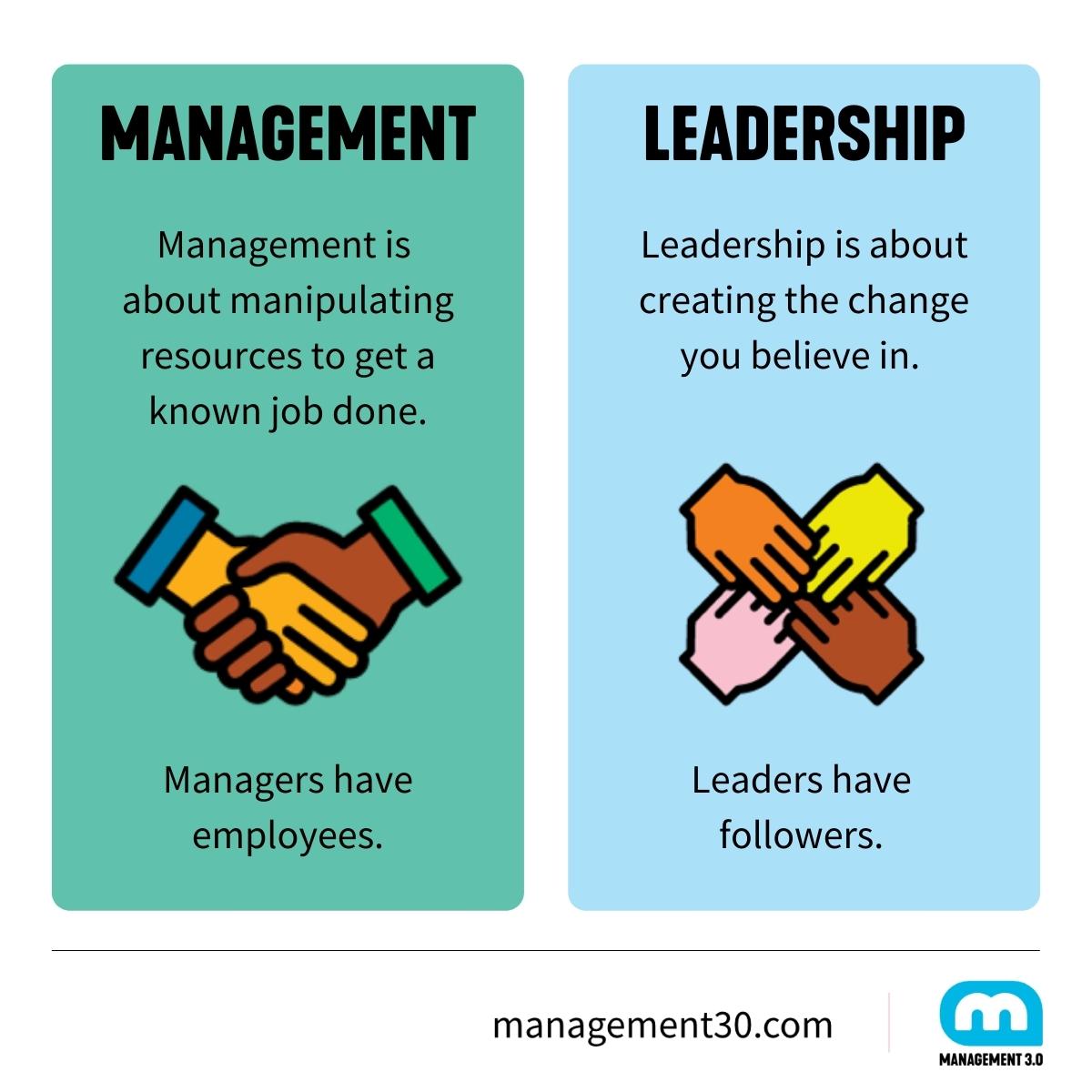An article by Voranc Kutnik, an Agile enthusiast fueled by his passion for collaborating with teams and guiding them towards embracing Agile values and principles to accelerate product development. Voranc has been a Management 3.0 Facilitator for over a decade and is one of the leading Agile experts in Slovenia. He possesses a wealth of experience in assisting organizations to enhance their agility by implementing Scrum methodologies.
In this article:
- What Does Agile Management Mean?
- What is an Agile Manager?
- What is a Manager’s Role in Agile?
- What is the Agile Management Style?
By adopting Agile management principles and practices, organizations can improve their ability to respond to rapidly changing business environments, deliver higher-quality products or services, and increase customer satisfaction.
Let us first go back to the early 20th century when Frederick Winslow Taylor, an American engineer, invented modern management as we know it today. He and several other prominent thinkers of that time defined the most basic principles of management which are still applied today in many organizations all over the world.
Traditional management principles are rooted in scientific management guidelines which focus on maximizing efficiency and productivity through the systematic analysis and optimization of work processes. Some key characteristics of traditional management include:
- Division of labor – work is divided into specialized tasks to improve efficiency and productivity.
- Hierarchy and authority – organizations have a clear hierarchical structure with a top-down flow of authority and decision making.
- Standardization and uniformity – standardized processes and procedures are implemented to ensure consistency and predictability.
- Centralized decision-making – decisions are made by top-level managers and cascaded down the organizational hierarchy.
- Strict control – managers exercise tight control over employees and closely monitor their work to ensure adherence to established standards.
- Emphasis on specialization – individuals are assigned specific roles and tasks based on their specialized skills and expertise.
Management expert and author Gary Hamel says that “the invention of traditional management was the biggest invention of the previous century.” I recommend watching his video Reinventing the Technology of Human Accomplishment in which he explains how Management 1.0 was born and why traditional management is not the best choice for today’s VUCA (Volatility, Uncertainty, Complexity, and Ambiguity) world.
Luckily, after a while, managers recognized that organizations cannot be operated as machines and that efficiency is not the only important metric.t Leaders learned that organizations are more successful if they place more emphasis on improving effectiveness, teamwork, empowerment, and the development of key competencies.
Peter Drucker, the father of modern business management, reinforced this mindset shift when he maintained that “Management is about human beings. Its task is to make people capable of joint performance, to make their strengths effective and their weaknesses irrelevant.”
What Does Agile Management Mean?
Agile management is not traditional management prefaced with the label ‘Agile’. It is not yet another management fad, in fact, it is a totally different breed of leadership style.
In Agile management, traditional linear and predictive project management methods are replaced with an iterative and adaptive approach.
Agile management is an approach to organizational management that emphasizes flexibility, adaptability, and responsiveness in a rapidly changing business environment. It helps the organization to improve its business agility which is defined in The Elusive Agile Enterprise report as a property of an organization to sense and respond to market changes and continuously deliver value to customers.
In accordance with this, Agile management values individuals and interactions over processes and tools, which is the first value in the Manifesto for Agile Software Development. It recognizes that traditional hierarchical structures and rigid processes may hinder adaptability and responsiveness. Instead, Agile management promotes collaboration, self-organizing teams, and iterative development cycles to quickly deliver value and respond to changing customer needs, as well as market dynamics.
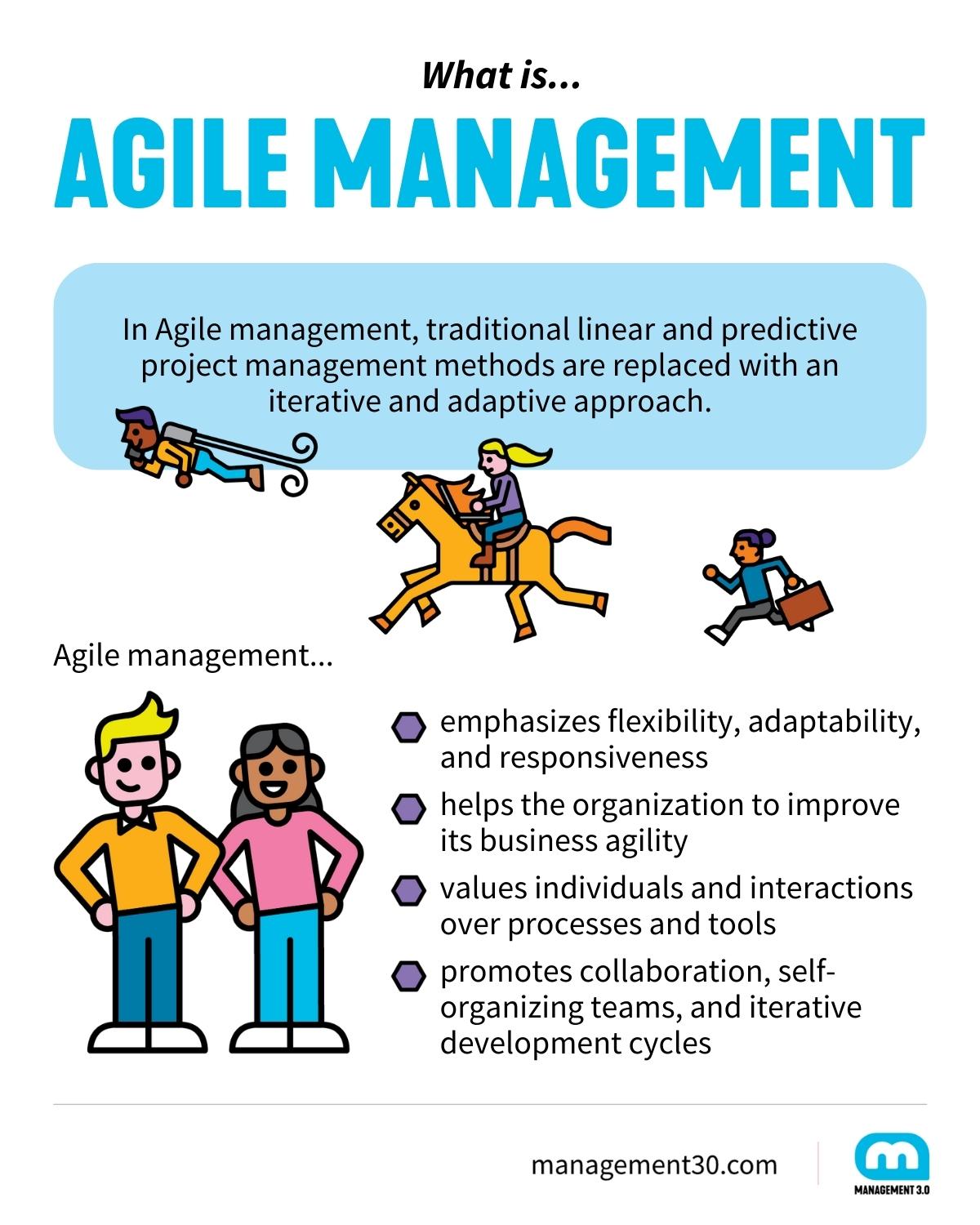
Here are three key principles of Agile management:
- Embracing change, complexity, and uncertainty – firstly, recognizing that change is inevitable and that business requirements and priorities will change over time. Secondly, embracing the uncertainty of the world we are living in.
One of the most complex problems that still remains unsolvable is how to fairly reward team members for their effort and contribution to the team’s success. Until we find the solution to this tricky problem, I recommend implementing the Merit Money practice which is a peer-to-peer bonus system.
At the beginning of an agile journey, the hardest truth for many executives to accept is that where to go and how to get there are not just unknown, they are unknowable.
Doing Agile Right
- Self-organizing teams – empowering teams to make decisions and take ownership of their work. Teams must take responsibility for how they collaborate, communicate, and adapt to meet their goals. Self-organization will not happen without delegating and empowering people to make decisions. As we know, the “right” level of delegation is a balancing act because it depends on a team’s maturity level and the impact of its decisions. I highly recommend reviewing the Seven Levels of Delegation and playing the Delegation Poker game before you naively delegate everything and hope for the best.
- Continuous learning and improvement – promoting a culture of learning, reflection, and adaptation. Agile managers should first and foremost lead by example and take the initiative to embody a growth mindset. Only then can they invite and encourage individuals and teams to identify areas for improvement and implement changes accordingly. There are many tools available to support this, but the Team Competency Matrix is still my favorite exercise for identifying skill gaps and helping teams to take concrete actions to fill those gaps.
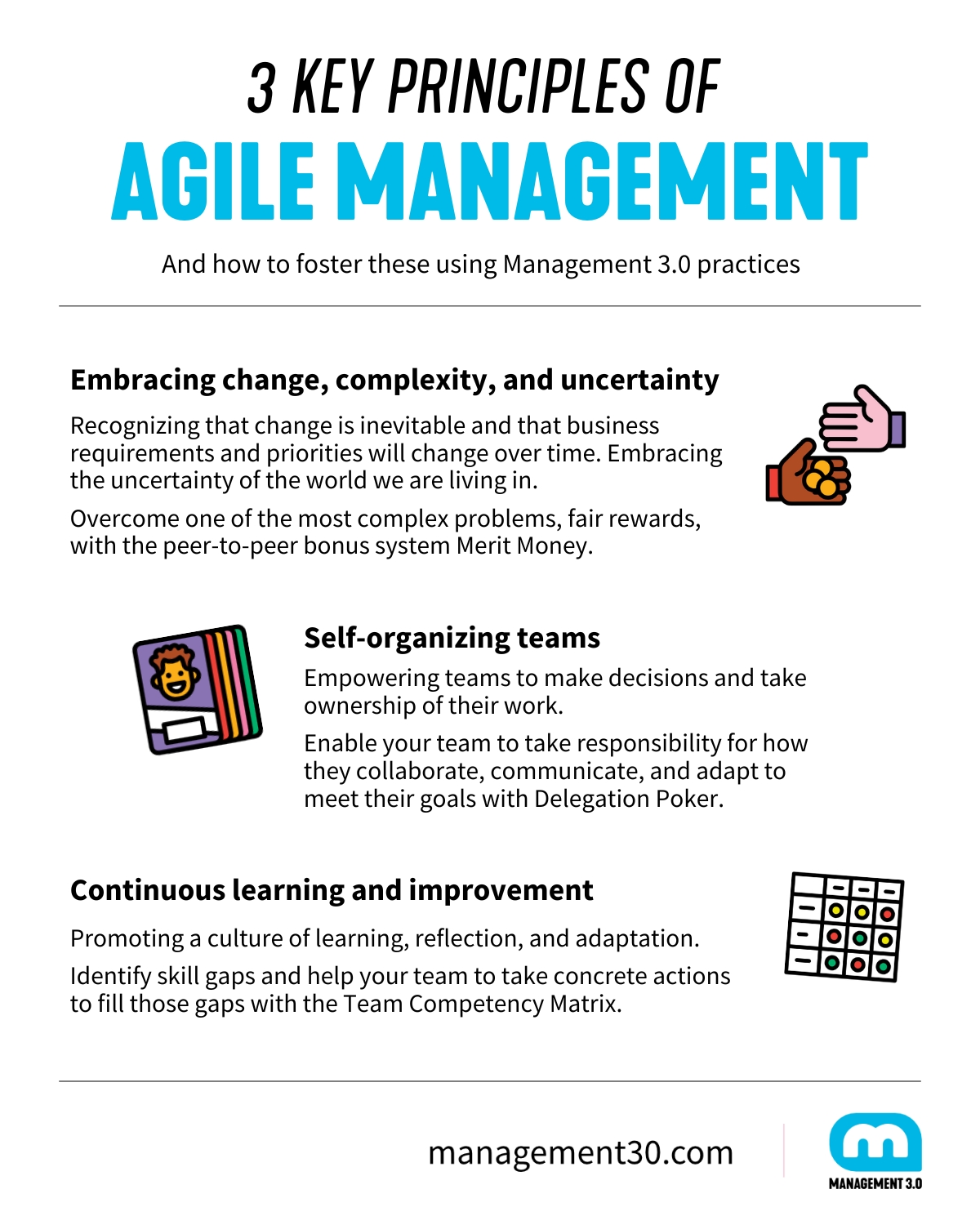
Of course, we cannot talk about Agile management without mentioning specific approaches that are aligned with the Agile mindset, values, and principles. The most popular and widely used is Scrum, which is a framework in which individuals can address complex problems. It involves practices like daily stand-up meetings, visual boards for tracking work, and regular retrospectives to reflect on progress and make adjustments. Implementing Scrum in an organization with traditional management will be a painful endeavor with a lot of frustrations, often resulting in a “fake” Scrum which is sometimes called a Zombie-Scrum. This quote from the book Doing Agile Right says it all: “When Taylorists try to implement agile bad things happen.” Remember, Agile teams and traditional management do not go together very well.
Overall, Agile management fosters a more dynamic and collaborative approach to managing individuals, teams, and organizations. It enables teams to quickly respond to market changes, deliver value in shorter cycles, and continuously improve their processes, resulting in increased customer satisfaction and business success.
What is an Agile Manager?
An Agile manager is like a captain who guides people and teams on a special mission. They want their team to be awesome and will do whatever is needed to help their team members succeed.
The accountabilities of an Agile manager revolve around team success, stakeholder satisfaction, effective processes and methodologies, team empowerment and growth, continuous improvement, and alignment with organizational goals.
The most important accountabilities of an Agile manager are:
- Team success – an Agile manager is accountable for the success of the team as a whole. This includes ensuring that the team understands its goals by facilitating collaboration and communication, and removing any obstacles that impede progress. The Agile manager supports the team in delivering the highest possible value to their customers.
- Team empowerment and growth – an Agile manager is accountable for fostering an environment in which team members feel empowered and supported in their professional growth. This involves providing guidance, coaching, and mentoring to team members, helping them develop their skills, and promoting a culture of learning and continuous improvement.
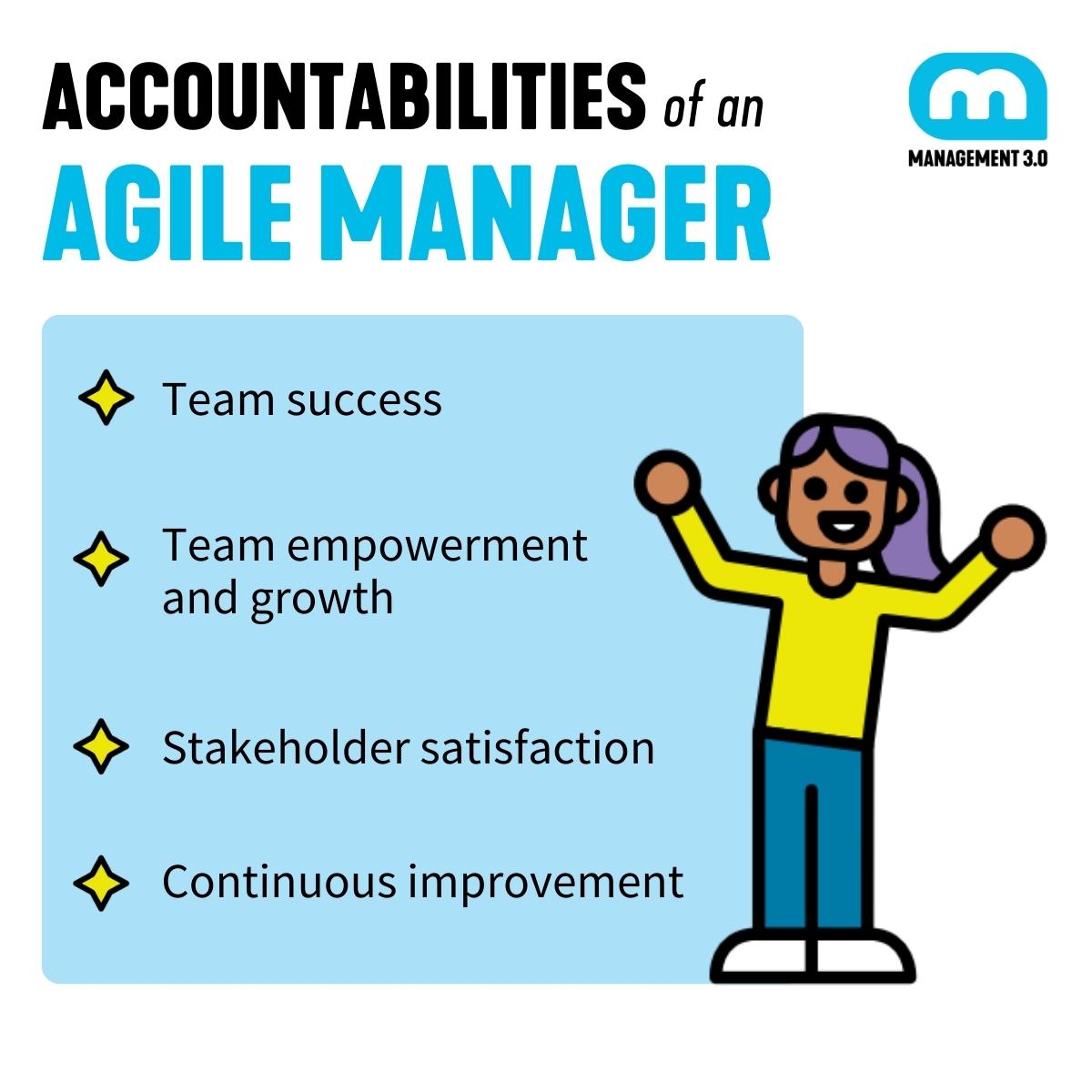
- Stakeholder satisfaction – an Agile manager is accountable for managing relationships with all stakeholders, including customers, clients, and internal stakeholders. The Agile manager ensures that stakeholder needs and expectations are clearly understood and incorporated into the work done by the team.
- Continuous improvement – an Agile manager is accountable for driving continuous improvement within the team and the organization. The Agile manager encourages the team to constantly reflect on their processes and performance, identify areas for improvement, and experiment with new approaches. The Agile manager supports the team in implementing changes and adapting to new practices that enhance the organization’s overall efficiency, effectiveness, and performance.
These accountabilities are very much aligned with the Management 3.0 Principles.
What is a Manager’s Role in Agile?
Let us make something clear: management is not leadership. There are many definitions of leadership and management and I tend to use this definition:
- Management is about manipulating resources to get a known job done. Managers have employees.
- Leadership is about creating the change you believe in. Leaders have followers.
We need both. Management is still very important, although leadership is more popular nowadays. Everyone wants to be a leader. Good management is crucial for the success of every organization. Management makes sure that I can buy fresh bread and milk at the supermarket every day.
Agile Management Style
Read the article What is Agile Leadership, and why is it important? if you want to learn more about Agile leadership.
In traditional organizations, management is done only by the managers. In Management 3.0 we say that management is too important to leave to the managers! We want to encourage all employees to co-create management in their organization. If we succeed in that, we can do all the management with fewer managers. But, for the managers still remaining, their role has changed.
In an Agile organization, the role of a manager undergoes a significant transformation compared to traditional hierarchical structures. Agile approaches, such as Scrum or Kanban, promote self-organizing teams and collaborative decision-making. As a result, the manager’s role shifts from a command-and-control style to that of a facilitator, enabler, and servant leader.
In an Agile organization, managers play a crucial role in fostering and promoting Agile mindsets throughout the organization. They encourage teams to embrace Agile values and principles, emphasizing agility, adaptability, collaboration, and continuous improvement. Additionally, they act as facilitators to ensure that teams have everything they need to succeed. They identify and eliminate any obstacles or bottlenecks that hinder the team’s overall progress. This can involve resolving conflicts, addressing resource constraints, or providing necessary support. They also help teams and individuals adapt to new ways of working, navigate transitions, and embrace emerging opportunities. Agile managers act as change agents, encouraging a culture of flexibility and resilience.
It is also important to note that the specific role of an Agile manager may vary depending on the organization’s context, size, and industry. However, as this article has demonstrated, the core principles of supporting Agile teams, enabling collaboration, and fostering a culture of continuous improvement remain fundamental to achieving true organizational and leadership success.

If you are interested in learning more about the role of management and leadership in Agile environments, this is discussed in our Agile Product Development module, as part of our Agility in HR and Agile Co-Creation Leadership Workshop.

